Dyson 360 Heurist vs Roomba S9 [Side-by-Side Comparison]
The Roomba S9 (or S9+) is iRobot’s top end vacuum cleaner so you can imagine it packs a punch. But, in this review we’ve pitted it against Dyson, a firm well known for its patented vacuum technology, with their second generation of robot vacuum; the Dyson 360 Heurist.
Both the Dyson and Roomba are high performing devices that would be a welcome addition to any home. However, the Roomba S9 was our overall preferred robot vacuum, thanks to a better all round clean, intelligence that helps it adapt throughout your home and added smarts such as the option for a self emptying base.
Table Of Contents
| Image | Summary | |
|---|---|---|
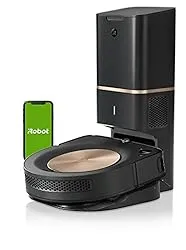 | Top Pick: Roomba S9+ • Self-emptying base • D-shape is excellent at cleaning edges and corners • Rubber rollers are great at picking up hair | View on Amazon |
 | Best Value: Dyson 360 Heurist • Patented cyclone technology for suction power • Slim design allows it to fit between obstacles | View on Dyson |
Overall Verdict
On the surface, these are two of the best robot vacuums currently available, with accurate mapping technology, great suction power and voice assistant integration.
However, dig a little deeper and you’ll find that Roomba have perfected the cleaning ability in the S9, both in terms of it’s shape which can reach the hardest parts of your home, and it’s intelligence which can automatically adjust it’s cleaning to suit different floor types.
Roomba’s dual rubber rollers make light work of hair which can get stuck in Dyson’s bristles, whilst the self-emptying base is a no-brainer if you’re trying to minimise your involvement in cleaning your home. All that being said, the S9 does have a much heftier price tag.
Winner: Roomba S9
Specs Comparison Table
[table id=5 /]
Dyson 360 Heurist: Pros and Cons
Launched in 2020, the Dyson 360 Heurist is the second generation of robot vacuum from Dyson. It is very different to other vacuums on the market with a tall but narrow design, tank treads instead of wheels and Dyson’s cyclone technology used in their traditional vacuums.
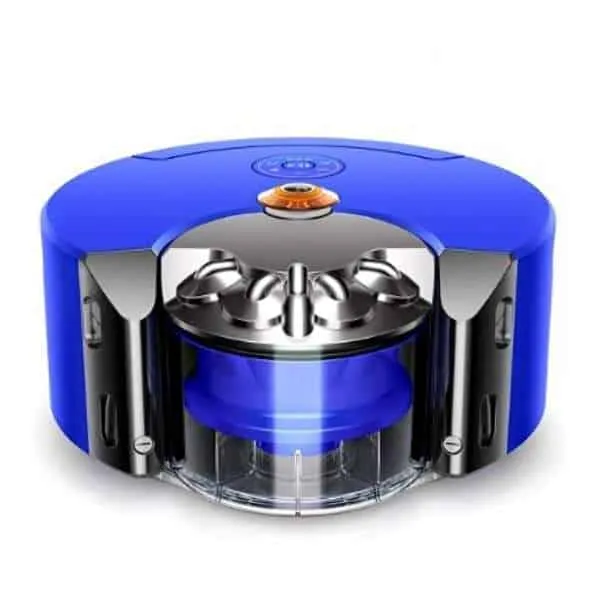
Powerful suction thanks to Dyson’s cyclone technology
Narrow width makes it easy to get around hard to reach areas
Far cheaper than the Roomba S9
Tall height means it can’t get under low furniture
Hairs can get stuck in the bristles and large particles can block the air filter
Small dust bin capacity
Roomba S9: Pros and Cons
The S9 is iRobot’s high end Roomba robot vacuum. It’s the only one in the range to take on a D-shape for added performance and claims 40x the suction power of the Roomba 600. It’s also available as the S9+ which includes a self emptying base.

Intelligent auto adjustments account for floor type to give optimum clean
Short height enables the S9 to get under couches and low furniture
D-shape and PerfectEdge tech give perfect coverage of corners and edges
Rubber rollers are well designed to pick up hair
Option for self emptying via the clean base
Wider than Dyson Heurist so may struggle with some chairs and smaller places
Most expensive robot vacuum
Clean base is quite obtrusive
Full Comparison: Dyson 360 Heurist vs Roomba S9
Now that we’ve covered off the key points, we’ll jump in to our full comparison of these two epic robot vacuum cleaners covering design, mapping, navigation, battery life, cleaning ability and other features.
Design
The design of the two couldn’t be further apart, the Roomba is short and wide, whereas the Dyson is tall and narrow. Each comes with its benefits, for example the Dyson is far better at weaving in and out of small areas such as between chair legs and under tables, whereas the Roomba can get under your sofa and other low furniture.
The charging base of the Dyson is also much slimmer and unobtrusive than the S9, especially if you opt for the beefy clean base which we’ll come on to discuss later.
As one minor note, we did like that the Dyson has handles on the side for picking up, whereas the S9 had no handle at all. Each robot has different advantages here, so we’ll call it a draw
- Dysons narrow design allows it to weave between smaller places like chair legs.
- Roomba’s short design means it can fit under couches and low furniture, plus the D-shape is great for corners.
Design Verdict: Draw
Mapping
The Dyson uses vSLAM mapping technology, it has a 360-degree lens camera that maps objects in its path and uses this to create a floor plan. Thanks to a complex algorithm it is able to map out your home on its first clean.
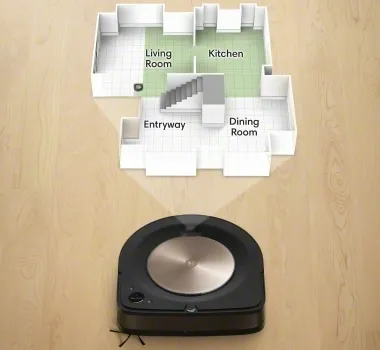
Roomba S9 Mapping (credit: iRobot)
The visual camera technology has meant that previous generations of Dyson robot vacuum have struggled in the dark, the Heurist fixes this with a ring of LEDs on top that provide light when cleaning in the dark so there are no issues here.
The Roomba S9 uses iRobot’s own take on vSLAM called imprint smart mapping, this uses optical sensors to create 3D maps of your home and is also able to complete this within the first clean.
Both robot vacuums have the ability to set up specific zones for room-by-room cleaning and to set virtual no=go zones so there is no need for physical beacons that some vacuums require. Both of the vacuums allow you to store multiple floor plans.
- Both the Dyson and Roomba use vSLAM to map your home with room-by-room cleaning and no-go zones.
Mapping Verdict: Draw
Navigation
In terms of how the two robots move around your home, again they are very different. The Dyson tends to cover your home one area at a time, ensuring that it’s covered the edges and any missed spots before moving on to the next part.
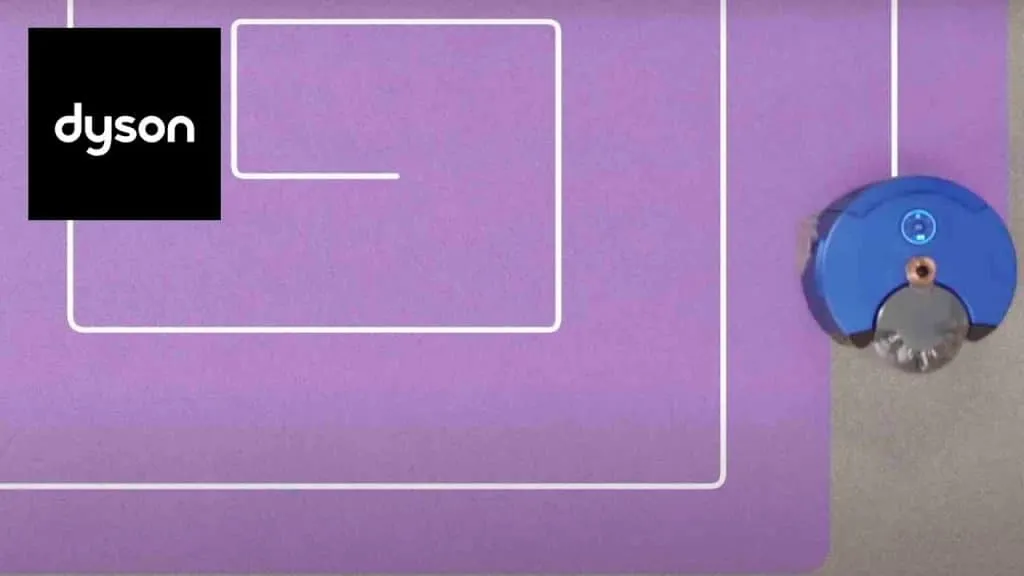
Dyson Heurist Navigation Path (credit: Dyson)
The Roomba S9 works in a different way, taking broad lengths across the room first before returning to cover missed spots and finishing off with the edges.
Although both use slightly different navigation methods, the coverage achieved by both is exceptional so there is no clear winner in that respect.
The Roomba’s unique D-shape help give it a great ability to reach edges and mean it is superb at getting right into corners, it provides an initial sweeping pass before returning to vacuum remaining particles. Meanwhile, the Dyson has a tendency to bump into your skirting board as it cleans the edges which can wear the paint on both the skirting board and the robot itself.
- The Dyson Heurist provides near complete coverage of your home in small squares.
- The Roomba S9 does broad strokes across the room before covering missed spots, it excels over the Dyson when it comes to edges and corners.
Navigation Verdict: Roomba
Battery Life
When it comes to battery life, both robots have recharge and resume capability. This means they can pause cleaning when the battery is low in order to recharge before returning to the same spot to pick up where they left off. This means that the argument over battery life is less important than with other robot vacuums.
Both the Heurist and the S9 have multiple power modes, but the S9 edges ahead on run time for both modes. The S9 can get around 60 minutes on high power mode compared to the Heurist’s 45 minutes, and around 120 minutes on low power mode compared to the Heurist’s 75 minutes.
- Both devices have recharge and resume so battery life isn’t overly important, however the Roomba does have a better run time in both modes.
Battery Life Verdict: Roomba
Cleaning Performance
Dyson are renowned for their vacuuming ability thanks to their patented cyclone technology that saw their upright vacuums garner so much success. This same technology is featured in their robot vacuum range too.
The suction power on this is incredible and does a stellar job at picking up smaller particles from right within the carpet, this is aided by its cleaning head being very close to the floor so there is little room for dust to escape. However, larger particles can block the air intake and cause the vacuum to stop cleaning and flashing its blockage light until you fix it.
The robot has a stiff brush that goes across the whole length of the robot to ensure maximum coverage, however one major area where the Dyson falls down is with hair. This gets tangled in the bristles of the brush and requires frequent cleaning.
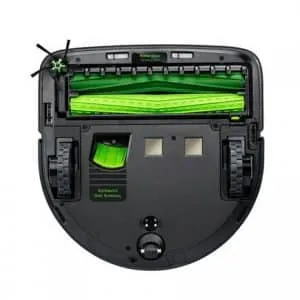
Base of the Roomba S9 with rubber rollers
(credit: iRobot)
Whilst Dyson’s cyclone technology might be world leading, the intelligence of the Roomba is what gives the S9 its edge. The robot has carpet boost technology, which automatically detect the floor type and adjust the suction power accordingly. It also has auto height adjustment of the cleaning head which helps it get closer to the ground where it needs a deeper clean.
In the S9, Roomba have perfected the areas where some of the other robots struggle, this includes the ability to pick up larger particles and fluff which have previously been blown away by the fast spinning brushes.
The S9 does a far greater job of tackling hair than the Dyson, it has dual rubber rollers that are far superior for hair than the traditional bristles on the Dyson. These do occasionally need cleaning but clip in and out really easily.
One final point to note is that the bin capacity om the Dyson is 330ml, far smaller compared to the S9 which is 550ml. With the Dyson’s great ability to pick up dust, this will soon fill up.
Whilst both the S9 and the Heurist outperform many robot vacuums on the market, the Roomba is our winner for cleaning ability.
- Dysons incredible suction makes light work of small dirt, however it struggles with hair and large particles frequently block it’s filter.
- The S9 has an excellent cleaning ability, adjusting for floor type as it goes and picking up hair easier than any other vacuum on the market.
Cleaning Performance Verdict: Roomba
Other Features
Both the Roomba and the Dyson have integrated their robot vacuums with Google Home and Alexa so that you can start cleaning with just your voice.
However, Roomba’s voice capabilities are far superior with the ability to clean certain rooms, set schedules or even tell it to clean near the sofa if you happen to spill something. Roomba also allows you to set names for your robots which is handy if you have multiple Roomba’s in your home.
That leads us nicely to the next benefit of the Roomba is that it works nicely with their Roomba Braava robot mop to coordinate cleaning between them. This ensures your home gets a thorough vacuum before the hard flooring is followed up with a mopping.
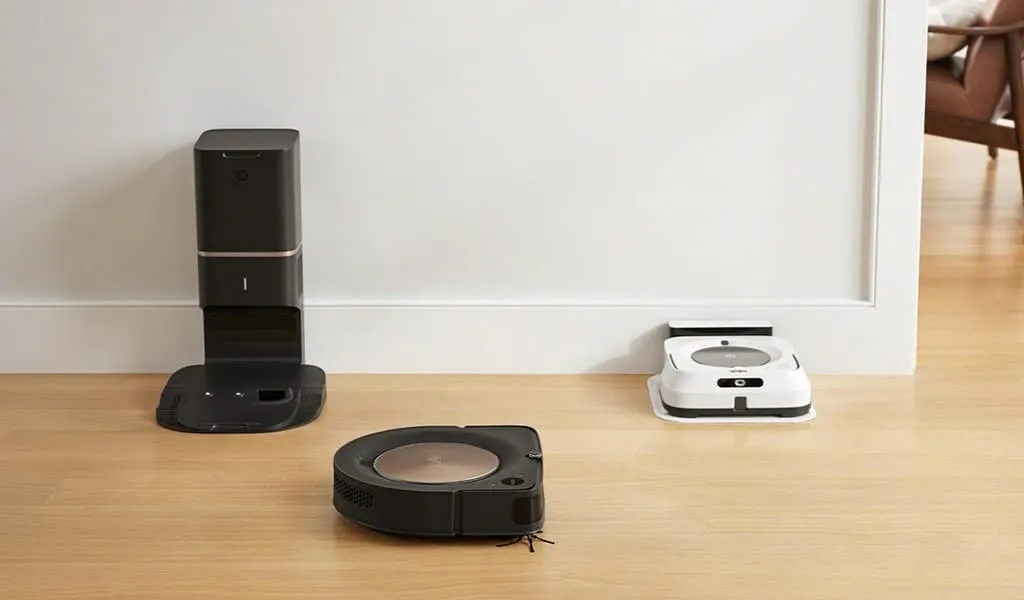
Roomba S9 with Braava and Clean Base (credit: iRobot)
The final point that we’ve already touched on briefly is Roomba’s clean base (also featured above). You can buy this separately, or you can purchase the S9+ (also called S9 Plus) which means the clean base is included.
When full, the additional suction motor in the clean base will empty S9’s onboard dust bin, enabling it to continue cleaning. It can do this 30 times before you need to empty it. The only downside is that the clean base is quite big and ugly, so you’ll need somewhere unobtrusive with plenty of surrounding space to keep it.
- Other than some voice interactions, Dyson has little to show off in terms of other features.
- The Roomba S9 has advanced voice interactions, can work in tandem with iRobot’s robot mop and has the option of a self emptying base.
Other Features Verdict: Roomba
Closing Thoughts
As we’ve already established earlier on, the Roomba S9 is our overall winner in this side by side comparison of the two bots. However, the Dyson does come in much cheaper and we’re sure most people would be satisfied with either of these two elites.
| Image | Summary | |
|---|---|---|
 | Top Pick: Roomba S9+ • Self-emptying base • D-shape is excellent at cleaning edges and corners • Rubber rollers are great at picking up hair | View on Amazon |
 | Best Value: Dyson 360 Heurist • Patented cyclone technology for suction power • Slim design allows it to fit between obstacles | View on Dyson |